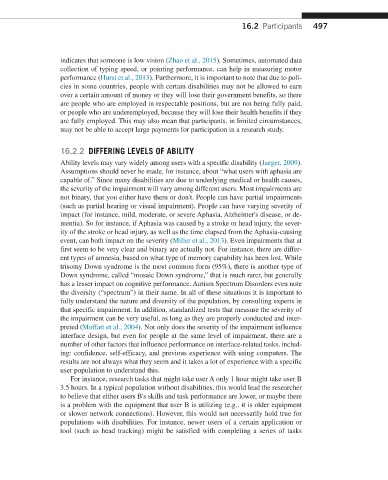Page 504 -
P. 504
16.2 Participants 497
indicates that someone is low vision (Zhao et al., 2015). Sometimes, automated data
collection of typing speed, or pointing performance, can help in measuring motor
performance (Hurst et al., 2013). Furthermore, it is important to note that due to poli-
cies in some countries, people with certain disabilities may not be allowed to earn
over a certain amount of money or they will lose their government benefits, so there
are people who are employed in respectable positions, but are not being fully paid,
or people who are underemployed, because they will lose their health benefits if they
are fully employed. This may also mean that participants, in limited circumstances,
may not be able to accept large payments for participation in a research study.
16.2.2 DIFFERING LEVELS OF ABILITY
Ability levels may vary widely among users with a specific disability (Jaeger, 2009).
Assumptions should never be made, for instance, about “what users with aphasia are
capable of.” Since many disabilities are due to underlying medical or health causes,
the severity of the impairment will vary among different users. Most impairments are
not binary, that you either have them or don't. People can have partial impairments
(such as partial hearing or visual impairment). People can have varying severity of
impact (for instance, mild, moderate, or severe Aphasia, Alzheimer's disease, or de-
mentia). So for instance, if Aphasia was caused by a stroke or head injury, the sever-
ity of the stroke or head injury, as well as the time elapsed from the Aphasia-causing
event, can both impact on the severity (Miller et al., 2013). Even impairments that at
first seem to be very clear and binary are actually not. For instance, there are differ-
ent types of amnesia, based on what type of memory capability has been lost. While
trisomy Down syndrome is the most common form (95%), there is another type of
Down syndrome, called “mosaic Down syndrome,” that is much rarer, but generally
has a lesser impact on cognitive performance. Autism Spectrum Disorders even note
the diversity (“spectrum”) in their name. In all of these situations it is important to
fully understand the nature and diversity of the population, by consulting experts in
that specific impairment. In addition, standardized tests that measure the severity of
the impairment can be very useful, as long as they are properly conducted and inter-
preted (Moffatt et al., 2004). Not only does the severity of the impairment influence
interface design, but even for people at the same level of impairment, there are a
number of other factors that influence performance on interface-related tasks, includ-
ing: confidence, self-efficacy, and previous experience with using computers. The
results are not always what they seem and it takes a lot of experience with a specific
user population to understand this.
For instance, research tasks that might take user A only 1 hour might take user B
3.5 hours. In a typical population without disabilities, this would lead the researcher
to believe that either users B's skills and task performance are lower, or maybe there
is a problem with the equipment that user B is utilizing (e.g., it is older equipment
or slower network connections). However, this would not necessarily hold true for
populations with disabilities. For instance, newer users of a certain application or
tool (such as head tracking) might be satisfied with completing a series of tasks

